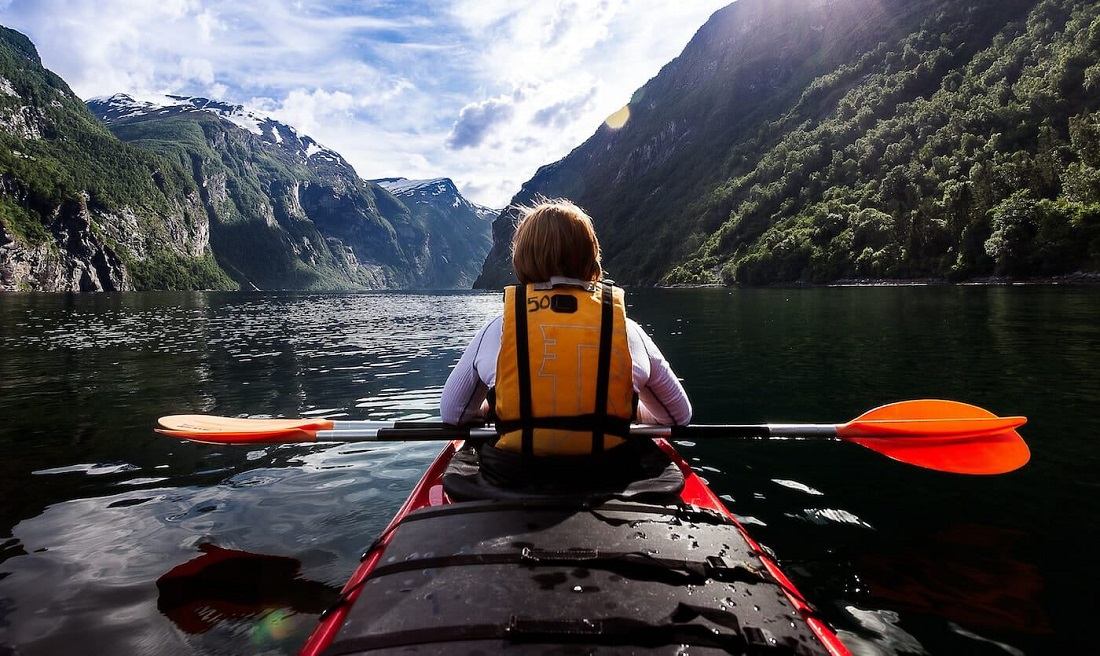Sitting in a kayak on a nice sunny day with a pleasant breeze on your face, surrounded by the scent of fresh water is a pretty amazing feeling. But, what happens if that nice breeze starts to pick up and the clouds roll in? Or if the water ends up being a little cooler than you thought? What clothes should you bring?
If you are a beginner kayaker, knowing what to wear kayaking in different weather conditions can be difficult, especially when temperatures start to get a little cooler.
You want to be prepared and keep your body at a comfortable temperature, but you also don’t want to overdo it and end up being too hot.
In this guide, you’ll learn what to wear for warm, cool, and cold paddling conditions so you’re prepared and comfortable for your next kayaking adventure.
Dress for the Weather Conditions
The first thing to remember is to dress for the conditions in the area you’ll be paddling. This means considering more than just the temperature and whether or not it’s sunny out. Here are some of the things you should keep in mind:
- Air temperature
- Water temperature
- Wind strength & direction
- Tides & currents
Winds, tides, and strong currents can all play a role in how rough the water is and how wet you’re likely to get. If it’s windy or cold out and you get wet, you’ll cool down up to 25 times faster than if you were dry.
Prepare for the Water Temperature
When you’re out kayaking, you’re dealing with two separate environments; the air and the water. It can be tempting to forget about the water temperature and just dress based on the temperature from your local weather forecast.
The reality though, is if you’re in a kayak surrounded by water, there’s a good chance you’re going to get at least a little wet. Tipping your kayak and getting completely soaked is a possibility as well, even for experienced paddlers.
In warm weather with warm water, this isn’t a big deal. However, when you paddle in cooler water, you need to carefully consider the clothes you’ll be wearing.
Kayaking in the Summer: What to Wear
Dressing for warm conditions is pretty straightforward, so we’ll keep this section short.
Your goal is to stay hydrated, cool, and protected from the sun. Here’s what you’ll need.
- Sunglasses
- Sunscreen
- Hat
- Long sleeve shirt
- Water shoes or sandals
Sunglasses
Polarized sunglasses can help cut the glare of the sun off the water. This can be a big plus if you expect to be looking at aquatic life underneath the surface of the water.
Sunscreen
Look for a sunscreen that is water resistant and with an SPF rating of 15-50. Reapply every 40-80 minutes depending on how water-resistant your sunscreen is.
Hat
Look for a wide-brimmed sun hat that will provide plenty of shade for your face and neck.
Long sleeve shirt
When the sun is very strong a long sleeve shirt can actually keep you cooler than a short sleeve one. Just make sure it’s breezy and light-colored. Shirts that offer sun protection is a plus as well.
Water shoes or sandals
Water shoes or sandals with a heel strap can be helpful if you plan to get in and out of your kayak and walk around, especially in rocky areas. Avoid sandals without a heel strap, as they tend to slip off at the most inconvenient time possible.
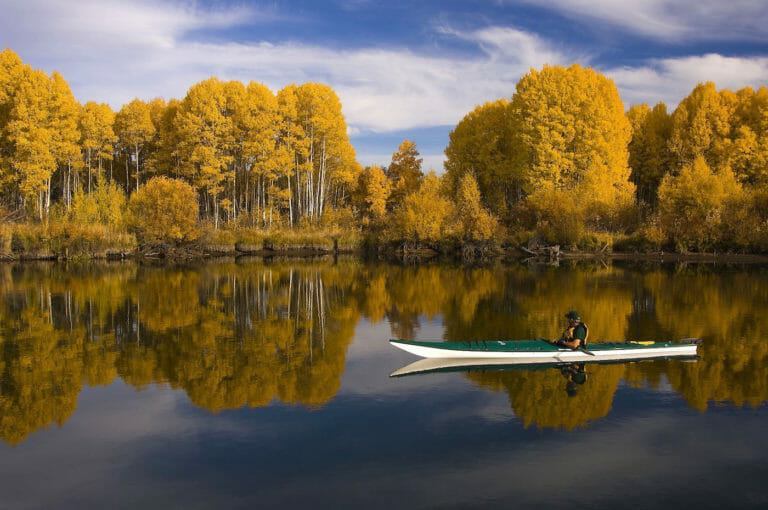
Kayaking in the Fall: What to Wear
In both cool and cold kayaking conditions, it’s essential to wear the right clothing to keep yourself warm even if you get wet. At the same time, you also want to prevent yourself from overheating while paddling.
This can be especially tricky if the air temperature is fairly warm but the water temperature is cold. Don’t make the all too common mistake of dressing just for the air temperature and forget about the water temperature.
It can get you into trouble if your clothes get soaked with water spray or if the kayak tips into cold water.
The keys to doing this are:
- Choosing clothes made out of the right materials
- Learning how to dress in layers
How to Choose Clothing Materials
There are several good options when choosing clothing material to take out kayaking. These can be split into two categories; synthetic and natural fibers.
There are subtle differences between the materials but choosing mostly comes down to personal preference and budget.
Avoid Cotton
Before discussing good material options, one critical point that needs to be made clear right off the bat is this: avoid cotton.
In the outdoors community, a common saying you’ll hear is ‘cotton kills’. Here’s why.
- Retains up to 27 times its weight in water – it’s heavy and takes forever to dry
- Is not moisture wicking – it’s uncomfortable when it gets wet
- And here’s the big one – cotton does not insulate when it becomes wet
Cotton is the absolute worst thing you can wear in a wet and cold environment. This includes your favorite pair of blue jeans.
Synthetics
Some of the best synthetic fabrics you’ll find for a cold and wet environment are:
- Polyester
- Nylon
- Polypropylene
All the above fabrics retain their ability to insulate when wet. They also absorb very little water and are quick-drying. When woven into a moisture-wicking weave, synthetics are great at moving moisture away from your skin.
They’re also very durable; a nice feature considering your clothing goes through a fair bit of wear and tear while kayaking.
If you’re working with a budget, take a look at clothing made from synthetic material, they’re typically cheaper compared to natural fibers.
Natural Fibers
Merino wool is the poster child for natural fibers that work well in outdoor environments. It does a good job keeping you warm when it gets wet, though, not quite as well as synthetics. It also does a good job at keeping you dry when woven into a moisture-wicking weave.
Besides being soft and comfortable, Merino wool does have one significant advantage over synthetics that you’ll notice on longer trips. Merino wool is naturally antibacterial, which helps it resist getting smelly during extended use.
One downside of merino wool is that it’s not as durable as synthetic fibers and is usually a bit more expensive. Wool also retains a bit more water than synthetics meaning it doesn’t dry out as quickly.
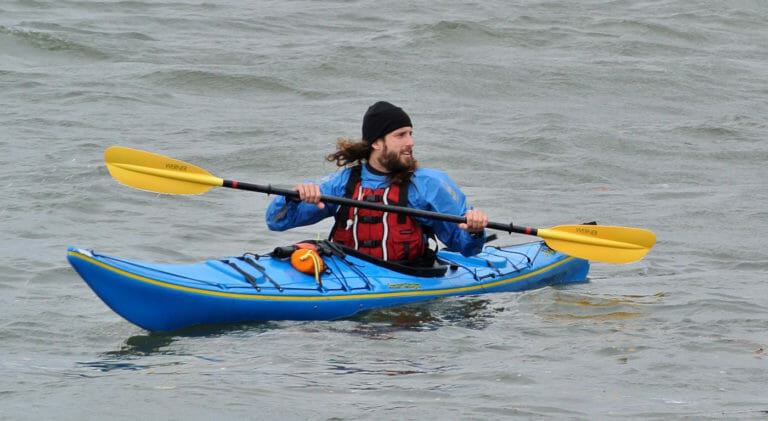
How to Dress in Layers
Layering for kayaking is similar to layering for other active outdoor sports. There are two main ideas.
- It’s better to dress in several thin layers rather than one thick layer
- Manage your temperature by adding or removing layers as conditions or activity level changes.
Here are a couple of examples of how this usually plays out:
- Did a cloud move in front of the sun and cause the temperature to drop? Add a layer to keep warm.
- Are you about to start an intense section of paddling? Drop a layer to prevent yourself from overheating and getting soaked with sweat.
The Layers
The layers you should be wearing can be broken down into 3 separate parts, each with their own purpose.
- Base Layer – wicks moisture away from your body to help keep you comfortable
- Middle Layer – insulates you and keeps you warm
- Outer Layer – protects you from the wind and rain
NOTE: You don’t have to start off wearing all the layers but it’s best to keep them on hand while you’re out on the water.
Base Layer
Base layers come in a variety of materials and different thicknesses depending on your level of activity and the temperature. The most important qualities of a kayaking base layer are:
- Sweat-wicking
- Retains heat when wet
- Fits comfortably snug against your skin
Most base layers use a sweat-wicking weave but double-check to be sure. These fabrics are woven together in a way to promote the movement of moisture away from your skin.
You also want your base layer to fit so it’s comfortably snug against your skin. If it’s too loose, it won’t be able to wick moisture away from your skin.
Make sure the fabric retains heat even if it gets damp. Synthetics like polyester and polypropylene have a slight advantage over merino wool in wet environments like kayaking, but merino is still a good option.
Middle Layer
Your middle layer’s job is to keep you warm if conditions get colder or if you take a rest and your body begins to cool down. You want something that:
- Insulates even when wet
- Is Breathable
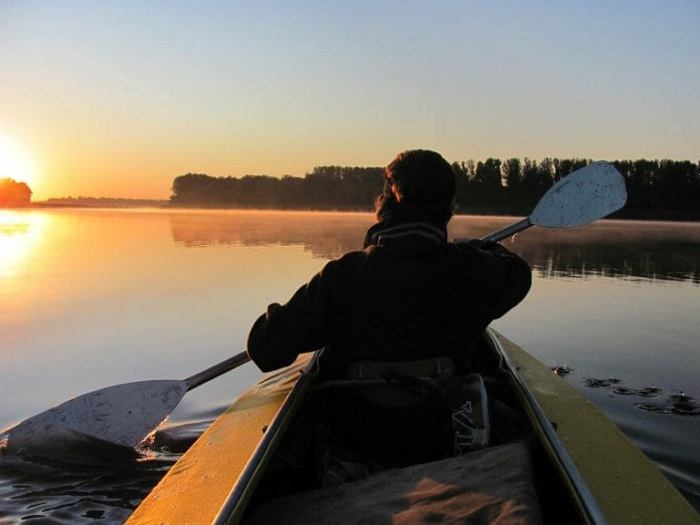
Polyester fleece is an excellent choice as a middle layer for kayaking. It’ll keep you warm and is breathable, which allows sweat in the form of water vapor to vent out away from your body. A nice bonus is polyester’s quick-drying characteristic.
Wool is another good choice but won’t keep you quite as warm as polyester fleece when damp.
Synthetic down is an ok option. It’ll still keep you warm, but it soaks up a lot of water and takes forever to dry out.
Unlike synthetic down, natural down is not a suitable choice for kayaking. It also absorbs a lot of water, but where it really falls short is that it loses its ability to keep you warm if it gets soggy.
NOTE: If it’s going to be particularly cold, you can add multiple middle layers for extra warmth.
Outer Layer
Your outer layer will protect you from the wind, rain, and water spray on choppy days. The best case scenario is for your shell to be:
- Waterproof
- Breathable
This is an ideal combination for kayaking, allowing perspiration to vent out while protecting against water and wind. However, outer shells that are both waterproof and breathable typically fall on the pricier end of the spectrum.
Water-resistant and breathable shells are another more affordable option. They’ll shelter you from the wind and keep you dry in a mild rain shower or from light spray. Just don’t expect to stay dry for long in very wet conditions.
Other Clothing Accessories
Footwear
There’s often a bit of water that sloshes around in the bottom of a kayak so, your footwear should be waterproof and insulated to keep your feet warm. Regular waterproof shoes or boots should get you by.
If you want to take a step up, neoprene booties are a good choice for colder water temperatures. They’re waterproof and will keep your feet warm. Consider the calf-high variety if you expect to be wading through the water to get in and out of your kayak.
Whatever you choose, make sure to wear wool or synthetic socks, not cotton.
Hands
Neoprene gloves are an option for keeping your hands warm and dry. The downside is that you lose some dexterity and they can be inconvenient to take off and put back on.
If it’s not too cold or windy out, some synthetic gloves may do the trick but it’s nice to have something wind-resistant if it’s cool out.
Pogies are essentially mitts that you can velcro around your paddle. You can then slip your hands inside of them to keep them dry and out of the wind. This is a particularly good option for cold or windy environments.
Head
Wool or synthetic beanies are a solid choice for keeping your head and ears warm. If it’s really choppy or cold out, you can also consider getting a neoprene hood but they can feel a little confining.
Kayaking in the Winter: What to Wear
When conditions are particularly cold, paddlers should take extra care to ensure they’re outfitted well and properly prepared. Hypothermia is a real danger even in water as warm as 60 degrees. Even more so at colder temperatures.
All of the concepts for layering and material choices are still relevant to cold weather conditions but paddlers should seriously consider the use of either a wetsuit or a drysuit.
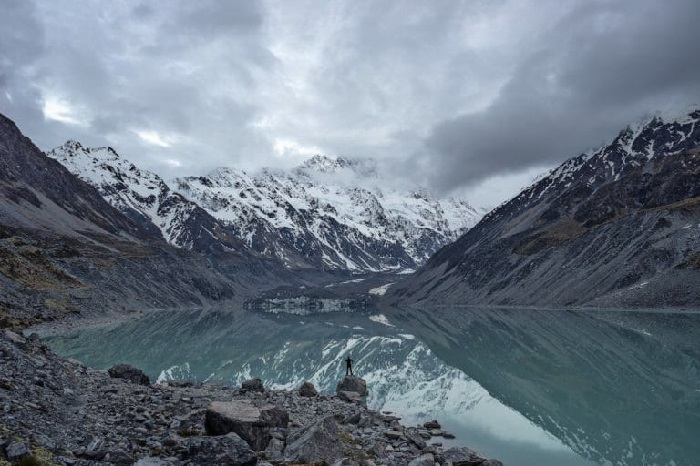
Wetsuits
Neoprene wetsuits are a good choice for moderately cold conditions. They come in different thicknesses depending on how warm you want them to be. You can get them in several styles including full body, sleeveless, and short-sleeve/shorts.
Neoprene will keep you warm if you get submerged in the water but in a bit of an unusual way. In the event of submersion, neoprene will trap a layer of water next to your skin. This water is initially the temperature of the surrounding water but will eventually be heated by your body and help keep you warm.
If you’re wearing a full-body wetsuit, there’s no need for additional layers but, a swimsuit underneath can make it easier to change out of your wetsuit if there’s no private changing area nearby.
If you’re using a sleeveless or short-sleeve wetsuit, consider using a snug-fitting base layer that dries quickly to cover exposed skin. Make sure to bring an insulating layer as well as an outer shell in case conditions deteriorate.
Drysuits
Drysuits are the ultimate option for cold-weather kayaking. It’s what scuba divers in the arctic wear to help keep warm and dry.
Unlike wetsuits, drysuits are intended to totally encase the wearer in a waterproof layer. They usually have latex or neoprene seals around the neck, wrists, and ankles to keep water out.
If you take a dip in one, it should keep everything except your hands, feet, and head dry. They’re a step up from wetsuits so expect to pay a bit more for one.
While drysuits act as an outer shell and will protect you from wind and water, that is typically all they are. Most don’t have any insulation and won’t keep you warm so, you’ll still need to wear your base and middle layers underneath.
Additional Considerations
Type of Kayak
Whether you’re in a sit on top or sit in kayak makes a difference in how exposed you are to wind and water spray and impacts how you should dress.
Sit on top
In a sit-on-top kayak, you’ll be exposed to the elements and you’re all but guaranteed to get wet. Even more so if there is any chop on the water or if it’s windy.
Also, consider that capsizing is much easier to deal with in a sit-on-top kayak. All that’s required is to flip the kayak back over and jump back on. You’re in and out of the water fairly quickly.
Sit in
Sit in kayaks protect the paddler from the elements and with the addition of a spray skirt, can help keep the lower half of your body warm and dry.
Dealing with a capsize is a bit more complicated with a sit-in kayak. Experienced paddlers can roll their kayak and flip the kayak right side up without ever getting out.
If you can’t roll your kayak, you’ll have to do a wet exit, flip the kayak over, then pump out the water inside the kayak before getting back in.
Capsize recovery takes time in a sit in kayak and you’ll be in the water a lot longer compared to a sit-on top.
Distance from Shore
When paddling near shore, you always have the option to return to shore and grab an extra layer if you get cold. If you tip the kayak and have trouble getting back in, you can always swim to shore and have your buddies collect your gear.
On the other hand, if you’re further out you won’t be able to return to shore easily to grab that extra layer. If you have trouble getting back in your kayak after a capsize, you could be in the water for a while.
The further away from shore, you are, the more important it is to make sure the clothes you bring with you give you the flexibility you need to deal with changing conditions.

